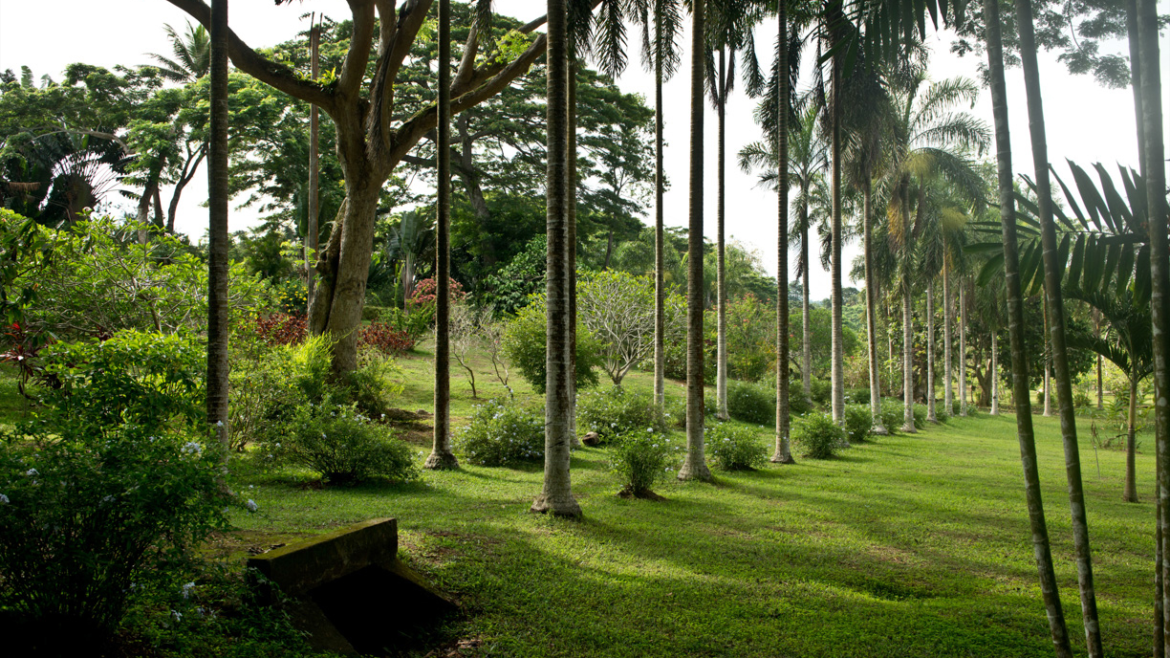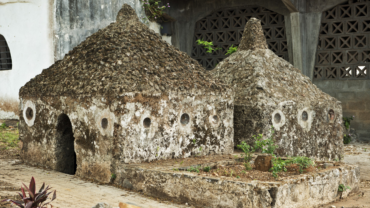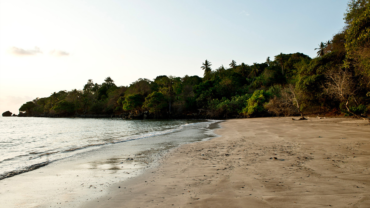Mayotte - Jewel of Nature
By putting down your suitcases in Mayotte, a change of scenery is guaranteed. Indeed, between the tropical climate, the omnipresent nature and the culture at the crossroads of the Indian Ocean, you can forget all your landmarks and let yourself be carried away by the charms of Hippocampus Island.
In the shade of baobabs, refuge of lemurs and jinns
In the heart of the Saziley Marine and Land Park (2,800 ha), and in the extreme south-east of the island, discover a pleasant, often shaded path.
From the village of M’tsamoudou, the path crosses an African savanna landscape. Baobabs, symbols of the coastal dry forest, emerge on either side of the bushy vegetation. Mayotte has two species, a unique phenomenon overseas: the African baobab with white flowers and the Madagascan baobab with red flowers, the latter species being rarer.
The lemurs, adorable lemurs signaling their presence with little cries, find refuge in these trees which seem to raise their roots in an unusual way towards the sky. The legend says that the baobabs would shelter the spirits of the ancestors (jinn). After a black pebble beach, you will tread the clear sands of the magnificent M’tsanga Saziley beach and swim to the coral reefs in the company of the turtles. In the distance will sparkle the astonishing “white sand island”.
Protected endemic species
Mayotte has a very rich fauna, some species of which are endemic to the island. Their fragile subsistence in an increasingly urbanized environment has led to the protection of these unique species that can only be found on these 375 km2 of land in the Indian Ocean.
The lemur, emblematic animal of Mayotte
The lemur (Lemur fulvus mayottensis), a species endemic to Mayotte, is an animal protected by the Washington convention.
Playful and mischievous, the lemur, although wild, can be sociable when you have bananas to offer. Their food consists of fruits, berries, nuts, leaves and sometimes insects and eggs. Active day and night, lemurs prefer a long rest around noon. During your walks in the forest, keep your eyes open because it is not uncommon to observe them in the middle of nature. It is estimated that there are currently 2,000 makis in Mayotte.
The Drongo de Mayotte, an endangered forest bird…
The Drongo de Mayotte is an endemic bird whose species is characteristic of the Mahorese forests. Considered to be very rare and threatened by deforestation raging in Mayotte in recent decades, this little-known bird was then classified as “critically endangered”. The drongos live in pairs, the male and the female are identical and produce powerful and rhythmic sounds. You can observe them in all the forest areas of the island except the dry forests of Saziley and the massif of Choungui.
The Souïmanga, bird close to man…
The Mayotte Souïmanga lives in pairs and often takes up residence in shrub beds that are often found in gardens such as bougainvillea, hibiscus or even multiplying palm trees. It is therefore possible to observe them all over the island because the Souïmanga has adapted well to contact with humans and it does not hesitate to nest in town. The oval ball shaped nest is constructed with intertwined dry grasses and spider web threads. These birds, which live in pairs all year round, have a very elaborate breeding strategy that allows the species to survive.
Hikes for all levels
What could be more beautiful and exotic than a dip in the tropical forest. In addition to its lagoon, Mayotte has a very rich forest. More than a hundred kilometers of marked hiking trails, allowing you to discover the island from the inside.
In Petite-Terre, the dziani mtiti
The Dziani Lake Crater Tour Trail is very easily accessible. As a family, from grandparents to grandchildren, everyone will enjoy a quiet ride with unparalleled views over the north of Mayotte. Mamoudzou facing this lake, the walker is both in the forest, but with a view of the urbanized capital.
North: the Dziani Bolé trail
This breathtaking path starts from Bouyouni and is appreciated for its authenticity. The walker will discover on his way a padza, the hill reservoir of Dzoumogné. It will also have a view of the port of Mayotte, one of the island’s economic centers. Then continuing north, it will cross Mtsahara and Mtsamboro with a view of the northern islets and even if the weather is clear, over Anjouan.
Center: The Chiconi-Mtsangamouji trail
This route allows you to cross the mangrove, a veritable aquatic forest, protecting the lagoon where the visible roots serve as filters for the lagoon. But above all, this path allows you to follow in the footsteps of history. A real plunge into the not so distant past where the Bambao company produced copra in Combani. A look back at colonization and the workers involved… with the remains of the Soulou sugar factory. It is also a shaded path which allows refreshing breaks in the rivers, and rich in perfume because it is strewn with giant cinnamon trees and ylang-ylang stems.
From Mtsamoudou to Dapani via Saziley, the landscape is splendid, with baobabs, pebble beaches or sands of all shades.
The hiking trails are not very long and are done in about three hours. Children of around ten can participate in this moment full of authenticity. With these trails of the GR, it is another tourism, greener that is practiced.
Coconi Botanical Garden
Discover the Coconi Botanical Garden, in the center of the island, and its plants from Mayotte.
In the center of Mayotte, Coconi is part of Ouangani, the only one of the 17 municipalities of the island without a coastal frontage. On an old agricultural estate dating from colonial times, the Coconi pleasure garden, managed by the General Council, lists magnificent orchids and presents, in a tropical, soothing setting of more than two hectares, a concentrate of plant species endemic to Mayotte.
Coconi botanical park, half an hour from Mamoudzou by car.
Duration of the visit: around 30min.
Child-friendly outings.
The scent island of Ylang
The bewitching scent of ylang-ylang, this delicate yellow star-shaped flower with six long petals will accompany each of your escapades on the trails of Mayotte.
Flowering takes place several times a year. The trees are recognizable by their gray bark and their tortured ramifications because they are topped off to remain at picking height.
Ylang-ylang is so intoxicating that it has seduced the most famous perfumers. You will meet several producers of ylang-ylang essence, distilling the flowers of their plantations in beautiful stills, particularly in the center of the island, around Combani. A visit to be privileged: the ecomuseum of vanilla and ylang-ylang.
Ylang Ylang Distillery Mayotte The distillation of fresh ylang ylang flower is done with water in stills which extract an essential oil in several fractions. Distillation lasts 12 to 20 hours, with the best fractions collected in the first two hours. The distiller adds more flowers as it is heated, approximately every 3 hours. The product of the different distillations is distinguished according to the density of the essence: Extra S, Extra, First, Second and Third. The Extra superior and Extra normal fractions as well as the First are intended for luxury perfumery, the Second and Third being intended for cosmetics, soaps and detergents. It takes about 100 kg of flowers to make 2 kg of gasoline.
The red desert of the padzas
This beautiful geological site is located in the south of the island: the red of the soil, the green of the surrounding vegetation, the blue of the lagoon make up a magnificent picture.
You access it by the lower part of the padza from the road. A few steps at the bottom of a gorge of red earth, dominated by steep walls whose crests stand out against the blue sky. A small staircase of stones wedged by an iron net allows you to climb in a few minutes to the platform. Up there, the view of the lagoon is exceptional. The color contrasts, so beautiful the good weather is part of the game, is striking.
hiking info:
Duration: 20min
Difficulty: very low
Advice: hold the hands of the children to climb the stairs and on the platform
The padzas
The padzas are the result of uncontrolled erosion. The bare ground is almost completely sterile and will silt up the lagoon with each new rain. The causes of this erosion are both human and natural: tropical showers, burns, deforestation, zebus and stray animals … The Department of Agriculture and Forestry began, in 1980, a rehabilitation section of the “padzas” with , in particular, tree plantations, including Acacia mangium.
Karihani lake
Lake Karihani, or ‘dziani Karihani’ in shimaoré, is the only natural freshwater lake in Mayotte. Often covered with water lilies and other aquatic plants, it attracts many birds all year round.
Refuge for egrets, herons and moorhens, the lake extends over several hectares during the rainy season (or ‘kashkazi’).
On the shores of the lake, grow cinnamon trees and passionflowers, a tropical climbing plant that gives passion fruit with a tangy flavor.
Cries of birds, water lilies, variety of green tones: the tour of Lake Karihani, near the village of Tsingoni, is a quiet and exotic stroll. In the gaps in the vegetation, you can contemplate a small beach and, in height, the village of Tsingoni. The path is on the right when coming from Tsingoni, about 1km from the college. Calm and serenity guaranteed.
Mont Choungui: A 360 ° panorama
Mount Choungui dominates the south of the island: its perfect and abrupt cone, 594 meters high, can be seen from both Petite-Terre and Sada. Its ascent, possible during the dry season, is one of the ‘must’ of the island.
The approach walk, from the village of Choungui, is easy. But part of the climb is very steep, requiring you to grab hold of the roots and logs.
At the top, a platform (hold children’s hands well) allows you to picnic in front of an astonishing panorama: lagoon as far as the eye can see, reef barrier hemmed in white, islets of Bambo and Bamdrélé, white islet, and colored reefs emerald, advances of Saziley, N’Gouja and Bouéni, the villages of Chirongui, Kani-Kéli, Poroani, the islet of Sada and even Petite-Terre!
Hiking Info:
Duration: 2 hours, including 20 minutes spent at the top
Difficulty: important
Advice: Not recommended for children under 12 years old. Provide appropriate supervision.
Around Lake Dziani, the emerald gem of Petite-Terre
The Dziani (lake in Shimahorais) Dzaha is an emerald green crater lake, located north of Petite-Terre. On the Badamiers road, the path climbs gently towards the path which encircles the lake. Take it in a clockwise direction. You will admire the Dzaoudzi rock, a former fortified capital, its marina, Grande-Terre and the turquoise waters of the large reef to the northeast.
From the faré magnificently overhanging the beaches of Moya, you can either go down towards them or complete the tour of the lake.
Hiking Info:
Duration: 1h30
Difficulty: easy (the path going around the lake is flat, but there is no shade)
Advice: do not go down towards the lake and hold the hands of children because the path is sometimes narrow.
The steps
Papaya, mangoes, passion fruits, bananas, pineapples, cassava, breadfruit.…
The colorful stalls run by women with nonchalant postures are where we find the largest variety of fruits and vegetables.
The new Mamoudzou market near the barge and the Tourism Committee offers a wide choice, while also exhibiting spices, clothing, fabrics and crafts. The Coconi farmers’ market, which is quite successful and brings together many artisans, opens the first Saturday of each month.





